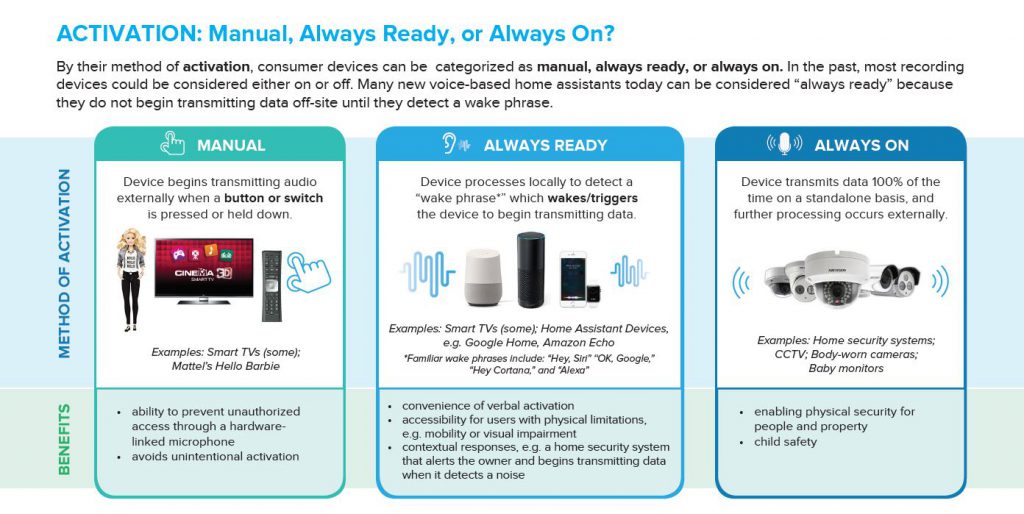New Infographic: Understanding Uses of Microphones in Internet of Things (IoT) Devices

FOR IMMEDIATE RELEASE
August 10, 2017
Contact:
Stacey Gray, Policy Counsel, [email protected]
Melanie Bates, Director of Communications, [email protected]
New Infographic: Understanding Uses of Microphones in Internet of Things (IoT) Devices
Washington, DC – Today, the Future of Privacy Forum released an infographic, “Microphones & the Internet of Things: Understanding Uses of Audio Sensors in Connected Devices.” In order to enable the benefits of new voice-based services while protecting data privacy, this infographic attempts to explain the range of possible uses of microphones in connected devices. Microphones & the Internet of Things describes to consumers in an easily digestible format: 1) how microphones are used in home devices, 2) the different ways these devices can be activated (“Manual,” “Always Ready,” or “Always On”), 3) the types of data that can be transmitted, and 4) current U.S. legal protections and best practices.
“Voice is an increasingly useful interface to engage with technology,” said Stacey Gray, FPF Policy Counsel. “Consider the Amazon Echo, which is activated by a spoken command (“Alexa”), or Apple’s personal assistant Siri (“Hey, Siri”), or the Smart TVs that are incorporating voice interactions. But consumers don’t always understand when and in what ways these devices are actually collecting information, leading to legitimate concerns that companies can address through transparency and strong privacy safeguards.”
By their method of activation, consumer devices can be categorized as manual, always ready, or always on. In the past, most recording devices could be considered on or off. Many new voice-based home personal assistants today are “always ready” because they do not begin transmitting data off-site until they detect a wake phrase. The infographic FPF released today describes these categories:
- manual (requiring a press of a button, or other intentional physical action);
- always ready (requiring a spoken “gate phrase”); and
- always on (device transmits data 100% of the time on a standalone basis, and further processing occurs externally).
Microphones & the Internet of Things also explains that microphone-enabled devices are not always transmitting the same kinds of audio data, or transmitting audio data at all. Some devices, such as smart speakers, can use microphones to do things like calibrate sound to the shape of a room for better music quality.
The publication of Microphones & the Internet of Things follows last year’s FPF paper, Always On: Privacy Implications of Microphone-Enabled Devices. The paper identifies emerging practices by which manufacturers and developers can alleviate privacy concerns and build consumer trust in the ways that data is collected, stored, and analyzed. Today’s release also coincides with the 2017 National Conference of State Legislatures Legislative Summit, where Gray spoke on a panel titled “The Future of Artificial Intelligence and Voice Recognition Technology.”
“Information networks and devices that make up the ‘Internet of Things’ promise great benefits for individuals and society,” Gray said. “However, if we do not have the right guiding principles or necessary privacy safeguards, consumers will lose trust in the evolving technologies. We need to address security and privacy issues to allow the Internet of Things to achieve its full potential.”
###
The Future of Privacy Forum (FPF) is a non-profit organization that serves as a catalyst for privacy leadership and scholarship, advancing principled data practices in support of emerging technologies. Learn more about FPF by visiting www.fpf.org.



